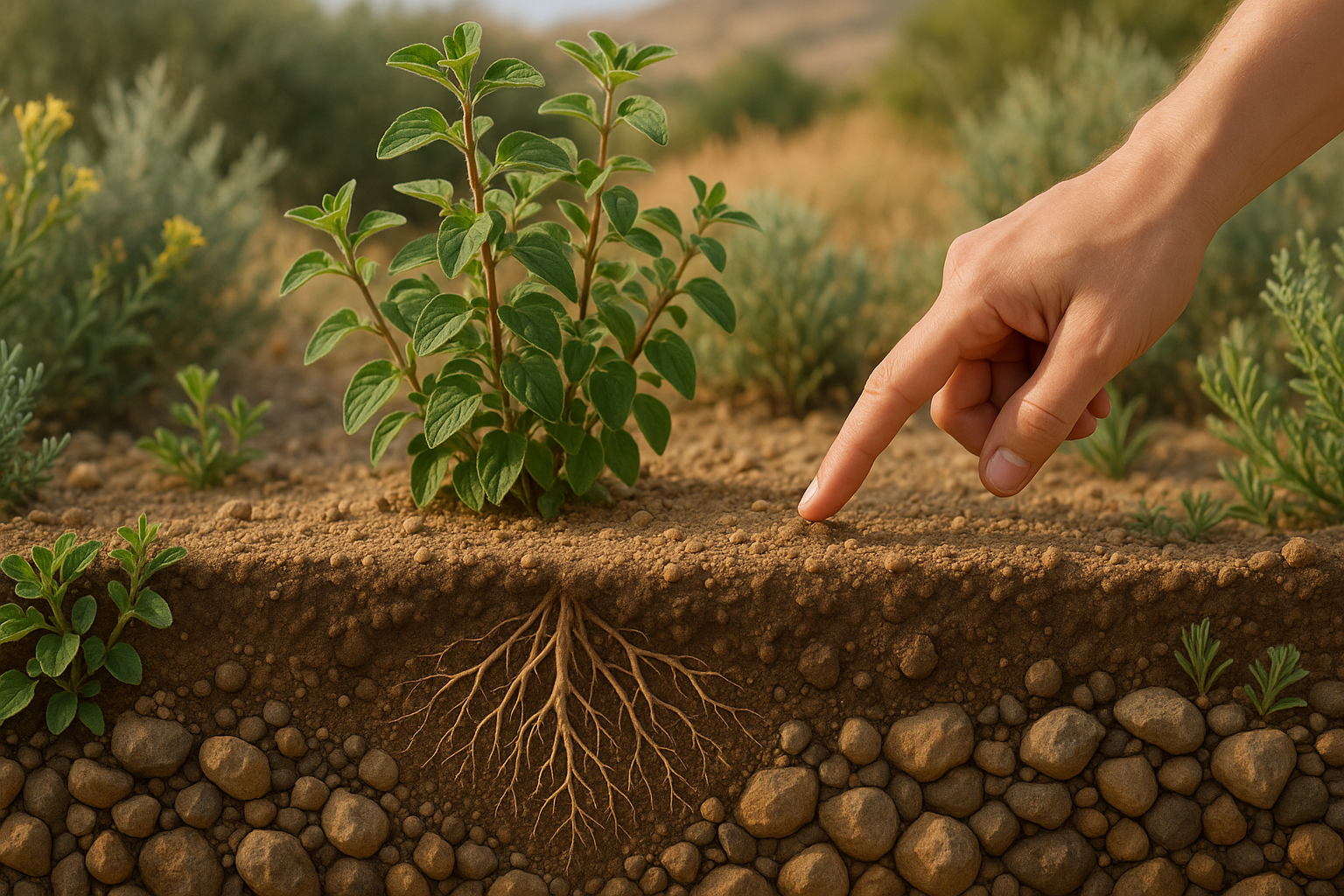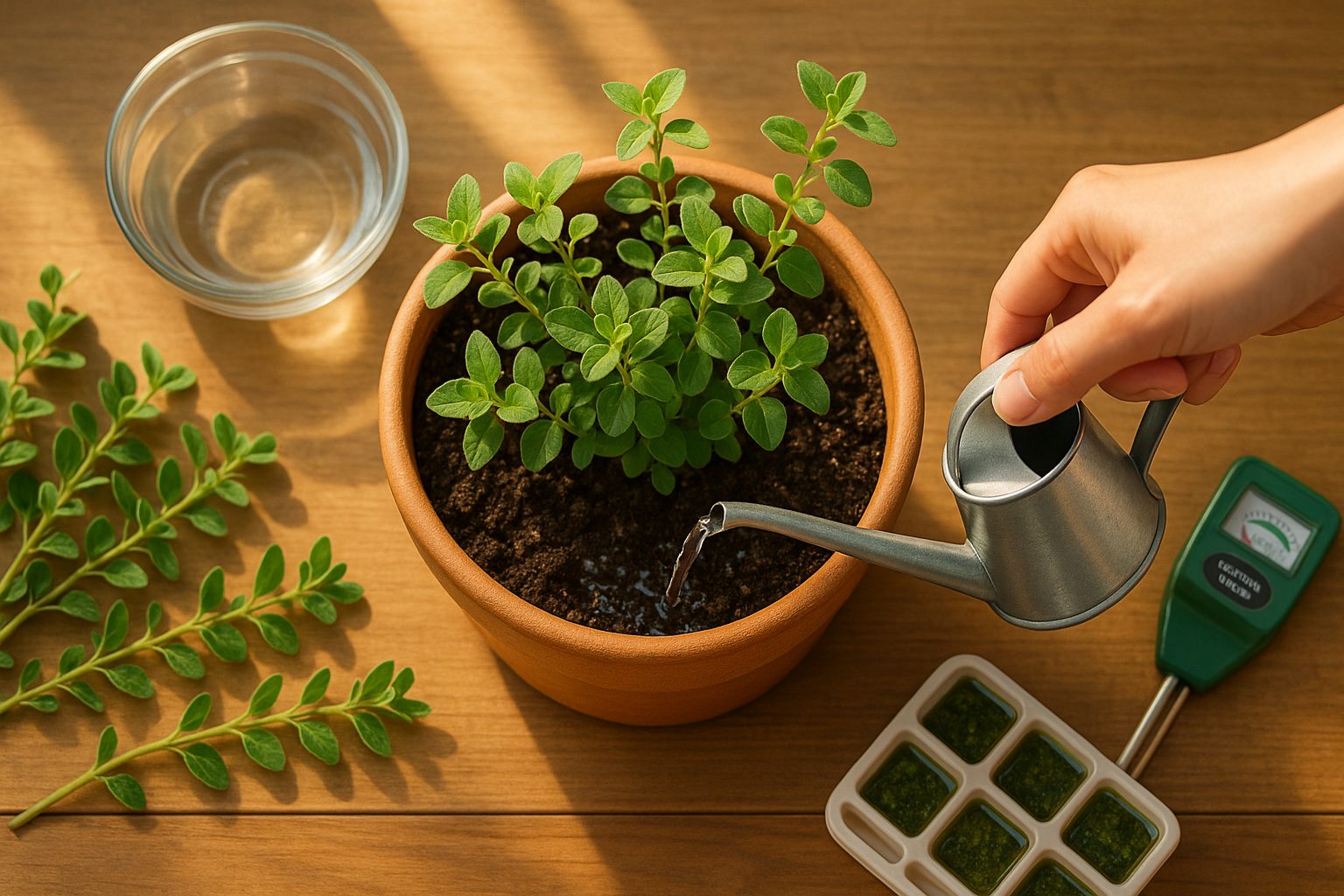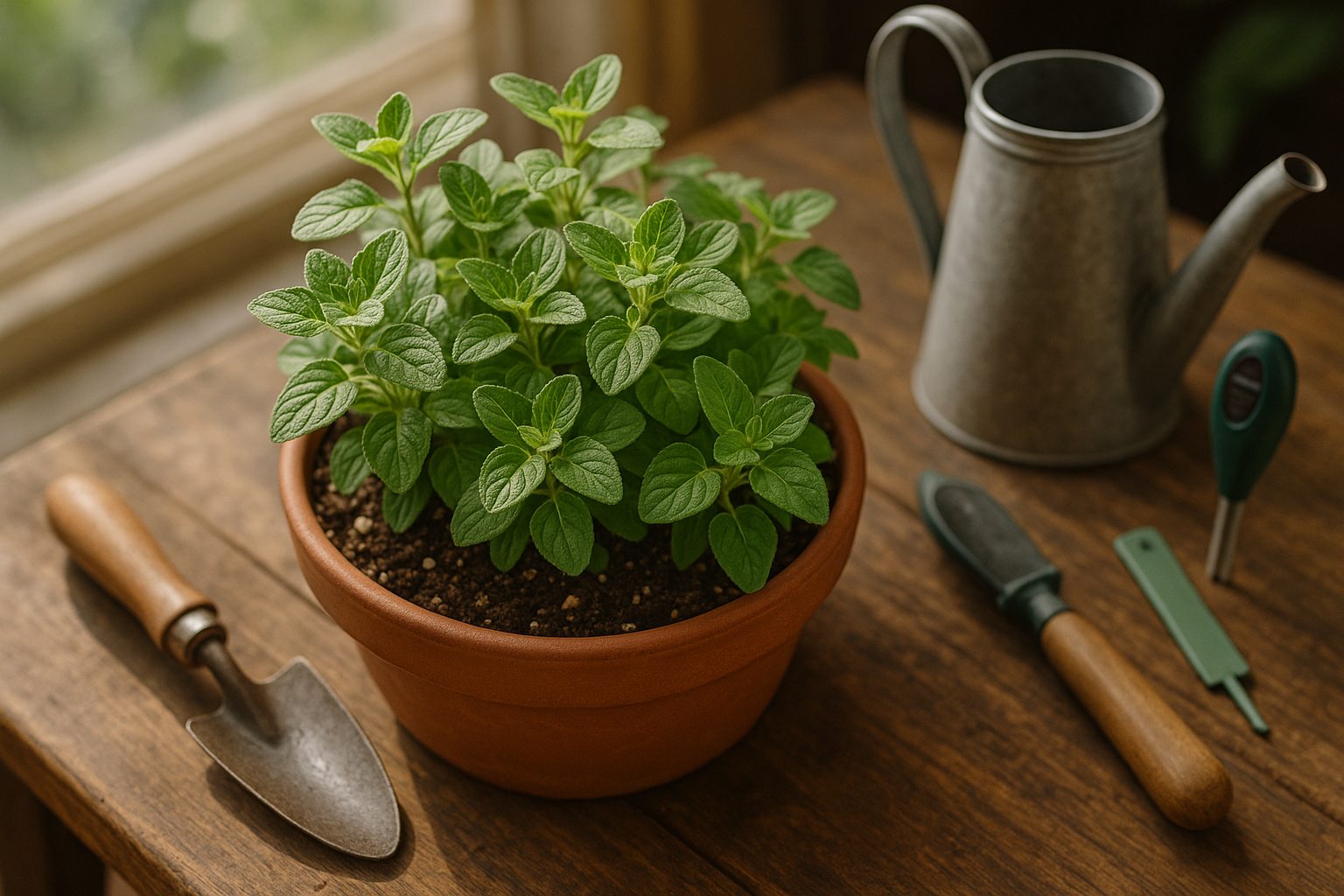Introduction
Watering oregano the right way is the secret to keeping this beloved Mediterranean herb thriving, whether it’s perched on your kitchen windowsill or basking in an outdoor garden bed. Oregano is a staple in countless kitchens around the world—it breathes unmistakable flavor into pizzas, sauces, and roasted dishes. But bringing that bold, fresh taste to your home cooking all starts with understanding the plant’s needs, especially when it comes to moisture. Watering oregano may sound simple, but too much or too little can quickly spell trouble for these hardy yet sensitive plants.
Getting it right means first looking at where your oregano lives. Indoors, conditions are typically more stable: less wind, no direct rainfall, and often reduced temperature swings. Outdoor oregano faces nature’s full spectrum—sunny heat, breezy days, and rain showers—which can dry soil more rapidly or, at times, drench roots unexpectedly. Each growing environment calls for a slightly different watering strategy to encourage those fragrant, tender leaves oregano is famed for. By tailoring your watering routine to match indoor or outdoor settings, you’ll boost the health and flavor of your herb, ensuring it rewards you generously come harvest time.
Understanding Oregano’s Water Needs

Oregano hails from the sun-soaked hillsides of the Mediterranean, where rocky soil and infrequent rainfall are the norm—these origins shape its ideal growing conditions. In the wild, oregano thrives in well-drained, sometimes even sandy or gravelly soil, which keeps its roots from sitting in moisture for too long.
This heritage makes oregano notably drought-tolerant compared to fussier herbs like basil or cilantro, which need more consistent moisture. For home gardeners, this means oregano can handle missed waterings and prefers drying out a bit between drinks.
In practice, watering deeply but infrequently—about once every week or so in warm weather—is best, allowing the soil’s top inch to fully dry out before the next soak. Overwatering is the main enemy; soggy roots can quickly lead to root rot, yellowing leaves, and a generally unhealthy plant.
On the flip side, chronic underwatering—letting oregano go bone dry for long stretches—can cause wilting, poor flavor, and stunted growth. A good rule of thumb is to check your plant’s soil regularly: stick a finger into the soil up to the first knuckle; if it feels dry, it’s time to water.
Whether growing oregano in garden beds or pots, always use pots with drainage holes and avoid heavy, clay-based soils to mimic the Mediterranean’s quick-draining conditions. By tuning in to oregano’s natural water needs, you’ll enjoy a hardy, fragrant herb that rewards you with vigorous growth and robust flavor season after season.
How Often to Water Oregano Indoors
For most indoor growers, oregano generally thrives when watered every 5–10 days, but there’s no one-size-fits-all schedule. Instead, your plant’s needs depend on several key factors.
First, consider the amount of sunlight your oregano receives: a plant on a sunny windowsill will dry out faster than one in a shady spot, so it may need more frequent watering. Humidity levels also play a big role—dry indoor air means the soil will lose moisture quickly, while a more humid room allows it to retain water longer.
Pot size and material matter, too. Small pots dry out more quickly, especially if they’re made of porous materials like terracotta, while larger or glazed pots hold onto water longer. Good drainage is crucial; always use a pot with holes at the bottom, and never let your oregano sit in a saucer of water, as soggy roots can quickly lead to rot.
Instead of sticking to a strict schedule, let the soil guide you: poke your finger about an inch into the soil, and if it feels dry, it’s time to water. Other signs that your oregano needs a drink include slightly wilted or drooping leaves, pale or slowed new growth, and a plant that feels lighter when you lift the pot. On the other hand, yellowing leaves and consistently wet soil suggest overwatering.
In summary, adjust your routine based on your indoor environment and pay attention to your plant’s cues—oregano is hardy and resists drought much better than it tolerates soggy roots. So when in doubt, it’s usually safer to wait another day before watering.
How Often to Water Oregano Outdoors
When it comes to watering oregano outdoors, how often you should reach for the hose depends on where and how it’s planted, as well as what Mother Nature is doing.
Oregano growing directly in garden beds typically needs watering every 7-10 days during dry spells, provided you have well-draining, loamy soil that holds onto just enough moisture without becoming soggy. Sandy soils dry out faster, so plants may need water every 5-7 days, while clay soils retain moisture longer, so check soil dampness before adding more.
In contrast, oregano grown in outdoor containers dries out much quicker — expect to water every 2-4 days, more often in hot or windy conditions, because pots lose moisture from all sides.
Your climate plays a key role too: in hot, dry, or windy regions, oregano needs more frequent watering, while rainy climates mean you can often rely on natural precipitation.
Make a habit of checking the top inch of soil: if it’s dry to the touch, it’s time to water, but don’t let oregano sit wet, as it dislikes soggy roots.
Seasonal shifts matter as well:
- In spring and early summer, when growth is rapid, oregano is thirsty.
- During the peak of summer heat, you may need to water more often, especially in containers.
- As fall brings cooler temperatures and less evaporation, cut back on watering to prevent root rot.
- Winter care is simple — if your area gets rain or snow, you’ll rarely need to water at all.
Real-world tip: stick your finger into the soil; if it feels dry an inch down, water thoroughly at the base of the plant rather than overhead. Err on the side of less frequent, deep waterings — this encourages deep roots and a tougher, more flavorful oregano plant.
Spotting Signs of Water Stress
Recognizing water stress in your plants is key to keeping them healthy, and knowing the difference between underwatering and overwatering can save you a lot of frustration. If your plant is underwatered, you’ll usually notice wilted, limp stems and leaves that turn dry, crispy, and sometimes brown around the edges. The soil will also feel completely dry a couple of inches below the surface.
On the other hand, overwatered plants often show yellowing leaves that may feel soft and limp. The soil might stay soggy or emit a musty smell—both signs that roots could be suffocating or even rotting.
To avoid these pitfalls, always check soil moisture before watering: stick your finger an inch or two deep. If it’s still damp, hold off for a day or two. Consider using pots with drainage holes and empty saucers promptly to prevent excess moisture from sitting around the roots.
If you accidentally overwater, let the soil dry out and remove any damaged leaves. With underwatering, increase watering gradually rather than drenching the plant all at once so roots can absorb moisture without shock.
Remember, every plant has unique needs, so do a little research on your specific species to create the best watering routine and adjust as the seasons change.
Best Watering Practices for Healthy Oregano

Keeping your oregano healthy starts with the right watering habits. Aim to water at the base of the plant rather than from above; this helps prevent fungal diseases by keeping the leaves dry. Use room-temperature water to avoid shocking the roots—a small detail that can make a big difference, especially for herbs grown indoors.
The best time to water is in the morning, giving the plant plenty of time to absorb moisture before the heat of the day and helping avoid overnight sogginess that can encourage root rot. Oregano thrives in well-draining soil, so if you’re growing it in pots, make sure there are holes at the bottom to let excess water escape. For garden beds, mix in plenty of coarse sand or gravel to promote good drainage.
Since oregano prefers to dry out a bit between waterings, check the soil before you water. The finger test is simple and effective—just stick your finger about an inch into the soil; if it feels dry, it’s time to water. For a more precise reading, use a moisture meter, which is an affordable tool available at any garden center.
By paying attention to these small details, you’ll avoid overwatering, one of the most common mistakes with oregano. Adopting these practices ensures your oregano has just the right balance of moisture to grow robust and flavorful.
Seasonal and Environmental Considerations
Seasonal and environmental changes play a huge role in how much water your plants need. In the sweltering heat of a summer heatwave, plants lose more water to evaporation and can dry out quickly, so you may need to water more frequently—sometimes even daily for outdoor container plants. Conversely, during rainy periods, nature does your job for you, so it’s important to check the moisture level of your soil before adding more water to avoid root rot.
Indoor plants are influenced by heating and air conditioning; heated winter air dries out soil and leaves faster, while air conditioning can sometimes slow plant growth and reduce watering needs.
Instead of sticking to a rigid watering calendar, get in the habit of observing your plants and their environment. Check the soil moisture by feeling a couple of inches below the surface, look for signs like drooping or yellowing leaves, and adjust how much and how often you water based on real-time conditions. This flexible, observation-based approach keeps your plants happier and healthier year-round, even as temperatures and humidity swing up or down.
Conclusion & Quick Reference Table
Watering oregano correctly is crucial for healthy, flavorful plants, whether you’re growing them indoors or outdoors. The key is consistency without overdoing it—oregano prefers to dry out slightly between waterings rather than sit in soggy soil. For indoor oregano, water about once a week or when the top inch of soil feels dry. Outdoor oregano, especially in warm weather, may need water every 4-5 days, but rainfall and soil type can change that. Always check the soil moisture with your finger and adjust accordingly. Watch for wilting or yellowing leaves as signs of over- or underwatering.
Environmental factors like humidity, pot material, and sunlight also play a big role, so use the schedule below as a starting point, not a strict rule.
| Setting | Watering Frequency |
|---|---|
| Indoor | Every 7-10 days |
| Outdoor | Every 4-5 days |
Stay observant, and adjust as your oregano flourishes!
